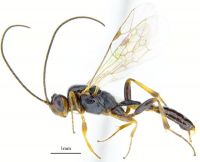ICHNEUMONIDAE: : Mesochorus Gravenhorst 1829
Diagnosis:
Characteristics of Mesochorus include: 1. Body size <10mm; 2. Position of spiracle on T1 at, close to, or before centre; 3. Large aerolet in forewing is rhombic (diamond); 4. Colour of face is not all black; 5. Metasoma compressed laterally; 6. Size of ocelli small; 7. Length of antennae varies, short, as long, or longer than body; 8. Length of ovipositor varies, barely visible, but not longer than body; 9. Wings present; 10. Colour of wings hyaline (clear); 11. Sternaulus absent, or short; less than 0.5x length mesopleuron; 12. Shape of face in lateral view flat or only weakly bulging; 13. Sternite on T1 (viewed laterally) not extending past spiracle; 14. Shape of T1 (viewed laterally) evenly curved; 15. Number of teeth in mandibles 2; 16. Metasoma same colour throughout; 17. Length of T1 vs T2 subequal in length; 18. Sculpture on mesoscutum finely pitted, many hairs; 19. Width of T1 (viewed dorsally) anterior part slender often parallel, strongly widening behind spiracle; 20. Glymma on T1 groove (not pit); 21. Sculpture on metasoma smooth with a glossy appearance (highly polished, no punctures); 22. Propodeum reaching past coxal insertion, but not reaching halfway along metacoxae.In males, the gonoforceps are extended into a very characteristic long and narrow rods.
Distribution in NZ
North Island: ND, AK, BP, CL, GB, HB, TO, WI, WN, WO. South Island: NN, SD, BR, MC, DN, CO, OL, WD, FD, SL. Offshore Islands: TH.
Species in NZ
An unknown number of species.Biology & hosts
Mesochorus is a very large genus with many species around the world (Gauld 1984). In many cases the species are very similar, differing slightly in colour pattern or superficial sculpture, and it is very difficult to determine if slight differences are inter- or intraspecific variation (Gauld 1984).Mesochorus are hyperparasitoids (i.e. they attack other parasitoids), their usual hosts are Braconidae (especially Microgasterinae) and less frequently Ichneumonidae and Tachinidae (Gauld 1984). Mesochorus is very widespread and common in New Zealand. However, there are no host records.
One species, Mesochorus pectoralis Ratzeburg,1844, is listed as present in New Zealand (Yu et al 2005). However, the original source of the record is Moss (1933), who documents a survey of the parasitoids of cabbage caterpillars, Pieris , in England. Moss (1933, p217) mentions Mesochorus pectoralis as a hyperparasitoid of Apanteles glomeratus (= Cotesia glomerata ) (Braconidae: Micgrogastrinae) but not from New Zealand.
Subsequently, Muggeridge (1933, p137) summaries biological control releases in New Zealand, and shows that Mesochorus pectoralis was reared in laboratory colonies imported from England. However, it is unknown whether Mesochorus pectoralis was unintentionally released into the field. Thus, record of this species in New Zealand should be treated with caution.
Sources of information
Gauld ID. 1984. An Introduction to the Ichneumonidae of Australia. London, British Museum (Natural History). 413 p.Moss JE. 1933. The natural control of the cabbage caterpillars, Pieris spp. Journal of Animal Ecology. 2:210-231.
Muggeridge J. 1933. The white butterfly ( Pieris rapae ) and its parasites. A record of recent control work. New Zealand Journal of Agriculture 47: 135-142.
Yu DS, van Achterburg K, Horstmann K. 2005. World Ichneumonoidea 2004. Taxonomy, Biology, Morphology and Distribution. CD/DVD. Taxapad. Vancouver, Canada.
Citation
Ward DF & Schnitzler FR. 2013. Ichneumonidae of New Zealand. Genus Mesochorus http://ichneumonidae.landcareresearch.co.nzAccessed: 10 March 2025



